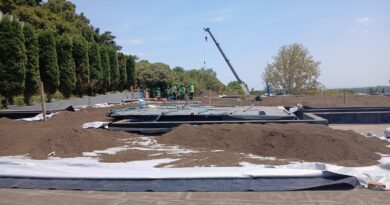Essential equipment for materials handling
Oscillating Systems Technology Africa – OST-Africa – specialises in the design and manufacture of screen, transmission and materials handling products, that prevent production losses and enhance safety during conveying in many sectors.
Advantages of OST systems – which protect the belt and conveyor truss from impact and vibration – are improved belt tracking, efficient spillage control and reduced downtime, resulting in improved productivity.
“Conveyor systems play a critical role in many industries – including mining, quarrying, construction and bulk materials handling – by automating the process of moving large quantities of materials from one point to another. Streamlined conveying operations enhance efficiencies, increase production and enhance safety on site,” explains Chantelle Scheepers, Marketing Manager, OST-Africa, part of Invicta Holdings Limited. “However, the constant impact from heavy loads, sharp materials and debris, can damage the conveyor system, resulting in unnecessary downtime and costly repairs.
“To combat this, OST-Africa has developed a highly-efficient spillage system, with important benefits over conventional systems, which are labour intensive, costly to operate and require additional equipment. The OST system encompasses various components that operate together to form one highly efficient system, with advantages that include simple installation, modular components for extended service life of the system, reduced maintenance and a low-cost solution to spillage problems. This system requires no additional support structures.”
The OST spillage system consists of a dynamic heavy duty impact bed, the High Impact Torsion (HIT) system, the skirt clamp and skirt wing, impact zone panels, duff feeders and the belt scraper range.
OST heavy-duty impact beds protect the conveyor belt from damage caused by heavy or abrasive loads, impact shocks and wear and tear. These robust impact beds are designed to enhance the efficiency of conveyors, by absorbing and cushioning the load at critical points, especially where the conveyor belt meets a transfer point or the chute, where fine or course heavy material is being transferred and where there is a build-up of materials in the transfer chute.
OST impact beds are specialised support structures placed underneath conveyor belts, primarily at the loading and unloading zones, to absorb the impact of bulk materials falling onto the conveyor belt. These heavy-duty impact beds – which are customised to specific requirements – ensure that the conveyor system operates smoothly at all times and also extend the service life of the system.
Key components of heavy-duty impact beds include impact liners which are typically manufactured from high impact, low friction HDPE material, known for strength and durability. These liners are arranged in rows to provide continuous protection across the width of the conveyor. This system offers reliable and cost-effective wear detection to indicate when replacement of a component is necessary. A pan head screw is inserted into the liner and as the HTPE cap on the screw wears away, it acts as a clear indicator that the liners should be replaced. Side panels, which are fixed and stationary, have an upward curve, to ensure optimal spillage control.
While the sides of the impact bed remain static and fixed in place, the centre section is designed to be more flexible. This flexibility is made possible by deflecting impact mounts, which allow controlled movement in the middle of the bed. This design helps absorb and distribute the force of falling material more effectively, thus reducing wear and tear. The number of impact mounts needed depends on the maximum load the bed is expected to handle during operation.
All OST products are built around the Neidhart system—a proven, high-performance design used globally in specialised materials handling applications. The system consists of three main components – an outer tube, inner tube and four specially shaped round rubber pieces positioned between them. When the inner tube rotates within the outer tube, it twists the rubber, generating a torsional force. This mechanism allows the system to absorb energy and dampen shocks, providing effective protection against impact and overload.
Advantages of corrosion resistant Neidhart units include natural oscillation and vibration damping, as well as shock load capabilities and extended service life. Most standard frames can be converted to suit Neidhart impact suspensions and mounting pitches are suited to fit existing stringers. No special support structures are required when using standard conveyors.
Typical applications for OST impact beds are in mining operations during the conveying of large, abrasive materials like ore, coal and gravel. In industries like cement, grain and fertilizer production, heavy-duty impact beds protect conveyor systems from the impact of bulk material loading, ensuring efficient material flow. Construction sites use conveyor belts to move aggregates and building materials and rely on impact beds to safeguard equipment and ensure smooth material transfer, even in rugged and high-load conditions. Impact beds also play an important role in recycling plants, during the handling of various materials, including metals, plastics and paper.
OST heavy-duty impact beds play a critical role during conveying, to ensure the reliability, safety and extended service life of conveyor systems, especially in industries where high volumes of heavy and abrasive materials are handled. By absorbing the shock and impact of falling materials, impact beds protect conveyor components and operators, resulting in fewer breakdowns, reduced maintenance costs and a smoother, more efficient materials handling process.
OST materials handling, screen and transmission products, are supported by specialised design and installation teams, which ensure these custom-built systems meet exact requirements in every application.







